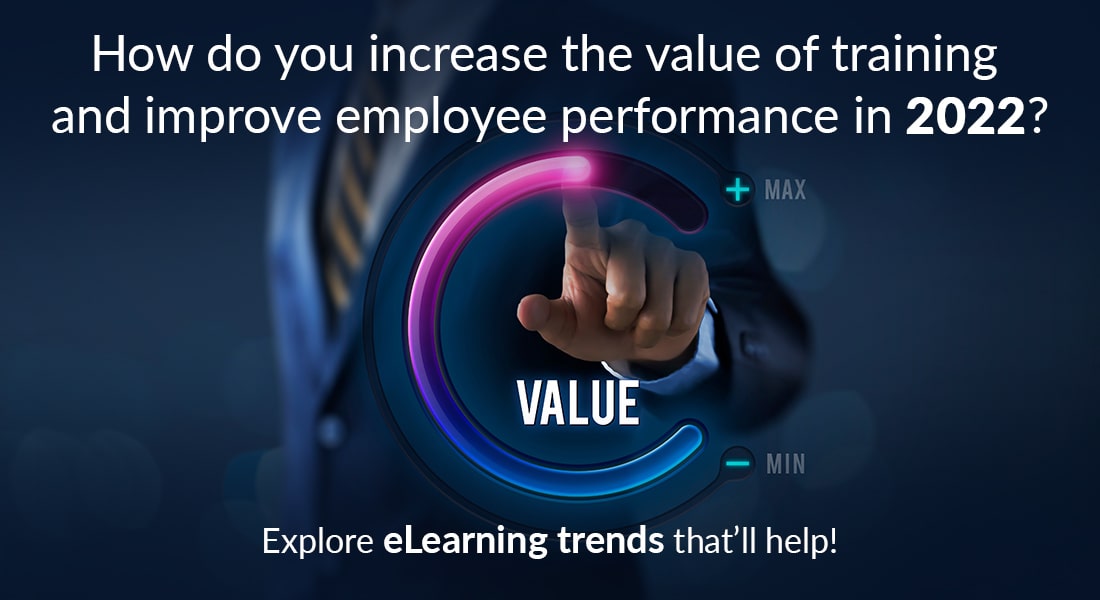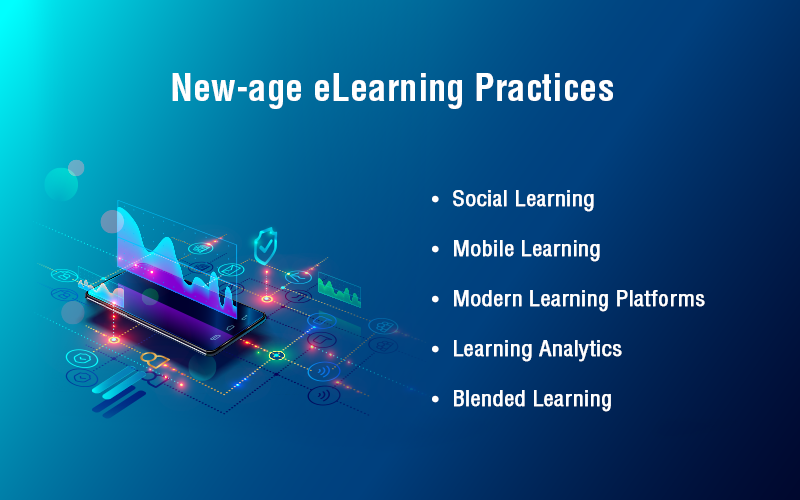eLearning Trends for 2022: What Should You Pick & Why?

It’s tough to make out the differences between the lists of eLearning trends that have been produced in recent years. To be honest, they’re so alike that you could simply flip between eLearning trends from different years without anyone realizing.
However, there is a valid reason for this monotony: corporate L&D has been static for a long time. Although there have been new training methodologies, authoring tools, and LMS capabilities, these eLearning trends haven’t been transformative. Or, at least, they weren’t until 2020.
Upskilling and reskilling are essential in today’s digital world. L&D must be hands-on with effective blended learning models and tools that make learning and communication seamless. So, let’s look at the highlights of everything that should be trending in your corporate training in 2022. Remember that the trend you pick for your organization should be based on what can genuinely change corporate L&D, not just what is in fashion.
What trends should you pick in 2022?
eLearning Trends for 2022
Trend 1: The Changing Role of Learning and Development
Training was always important to enterprises, only now it has become even more so because of remote working, virtual teams, changing business processes, and external factors.
According to the 2021 Workplace Learning Report by LinkedIn Learning, globally, 64% of L&D professionals feel that L&D has progressed from a “good to have” to a “need to have.” And L&D needs to transform from being mere order-takers to impact-makers! And that would entail L&D to:
- Become more in sync with the organization’s vision and goals
- Ensure that training programs are in line with company objectives
- Demonstrate training effectiveness
eLearning Trends for 2022
- The Changing Role of L&D
- The Shift from the Physical to the Virtual Space
- The Evolving 70:20:10 Model
- Upskilling and Reskilling
- Digitization of Top Training Programs
- The Modern Training Manager’s Toolkit
- In-house Design Team with Rapid Outsourcing!
Trend 2: The Shift from the Physical to the Virtual Space
Communication and learning have shifted to the virtual environment as firms adapted to virtual teams and remote workers. A huge number of organizations are shifting their budgets from ILT (classroom training) to online learning, as virtual (online) training has proved to be effective to ensure continuous training and to prepare employees to deal with change.
Popular online formats include:
- Immersive eLearning
- Videos
- Virtual instructor-led training (VILT)
- Microlearning
- Knowledge databases and performance support
Let’s now take a closer look at some immersive eLearning strategies and how you can implement them in your training.
Personalization
Involve learners in the course. Some tried-and-tested ideas include:
- Welcoming the learner by making him type in his or her name, and address them by name throughout the course, especially when giving feedback.
- Providing a pool of characters (avatars) and allowing the learner to select their own guide to take them through the course.
- Offering role-based training, allowing learners to select their own learning paths, based on their roles.
Storytelling
The best and most effective learning is achieved through stories. Design your courses with:
- Scenarios to help learners handle real-life situations in a risk-free setting
- Case studies to help strengthen their decision-making or conflict-resolution skills
- Comic strips to add a light touch or as transitions
Trend 3: The Evolving 70:20:10 Model
With online training and social distancing, the scope for and importance of formal training is increasing – along with the need for collaborative learning. These changes have impacted the 70:20:10 model – the bedrock of corporate training – which is undergoing a shift to 55:25:20!
The 55:25:20 model is a perfect fit for blended learning with different formats that will help build a robust training program.
Online Training Formats for the 55:25:20 Model
|
Experiential (55%)
|
Social (25%)
|
Formal (20%)
|
For more insights on blended learning, get this eBook now.
Trend 4: Upskilling and Reskilling
Most organizations saw massive downsizing and restructuring to adapt and survive in the pandemic-ridden world. Upskilling and reskilling became the need of the hour due to:
- Rapidly evolving processes and technologies
- Skills gaps and the need to fill positions internally
- Employees having to work and thrive in a changing environment
A learning management system (LMS) is a natural solution for reskilling. It can help identify employees who have at least some of the necessary training for a job task. Or employees who could transition to a new role or department.
Clear learning paths that build the necessary skills and knowledge for a new job are an important part of these initiatives. There are a variety of ways to implement reskilling and upskilling initiatives, depending on your learning platform.
Trend 5: Digitization of Top Training Programs
Many classroom-intensive training programmes that were previously thought to be only practicable in a physical environment are increasingly going online. These training courses are distinguished by the requirement for supervision, collaboration, and on-the-job training. Some of the popular training types moving online:
- Onboarding
- Technical Training
- Leadership Training
Trend 6: The Modern Training Manager’s Toolkit
When it comes to tools, the modern training manager is no longer a newbie, opting for products that are simple to use and fulfil IT requirements.
Training managers need to be hands-on with authoring tools. LXPs (Learning Experience Platforms), and other tools that save time.
Popular eLearning authoring tools for rapid development:
- Articulate Storyline
- Adobe Captivate
- iSpring
Trend 7: In-house Design Team with Rapid Outsourcing
Most organizations have competent design teams in-house. They are, however, preferring to outsource eLearning development (sometimes design too) to external vendors to:
- Meet the need for scalability and speed in rolling out training courses
- Gain access to the vendor’s authoring tool expertise
- Free their internal teams to work on high-priority, proprietary projects
- Enjoy hassle-free, error-free translations
To Summarize!
It’s an exciting time to be in the L&D team! To create learning solutions that boost employee performance! But to deliver effective results and become actual impact-makers, L&D needs to be hands-on with effective blended models and technologies that make learning and communication effortless. If you are a training manager or work in the L&D field, join the webinar “eLearning Trends 2022: The View from the Trenches”!





![eLearning Trends for 2021: What Should You Pick & Why? [Infographic]](https://blog.commlabindia.com/hubfs/Imported_Blog_Media/elearning-trends-corporate-training-info.jpg)